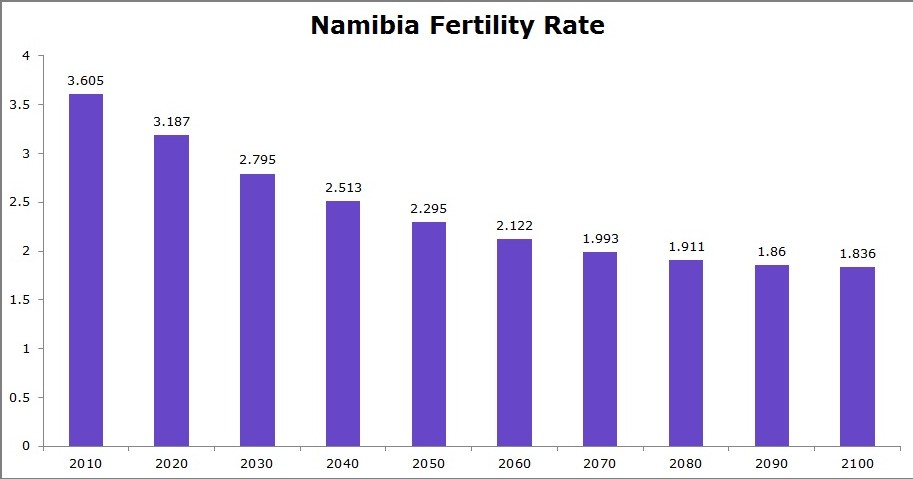Namibia, like many other countries in sub-Saharan Africa, has experienced significant demographic shifts in recent decades. One of the most notable changes is the drop in the country’s fertility rate, which has now fallen below three children per woman. This marks a significant shift from the country’s historical fertility trends, where larger families were common, to a more moderate growth rate in the population. This article explores the factors behind Namibia’s declining fertility rate, the potential consequences for the nation, and the broader implications for development, gender dynamics, and social structures.
Understanding Fertility Rate and Its Importance
Fertility rate refers to the average number of children born to a woman during her lifetime. A fertility rate of about 2.1 children per woman is considered the replacement level, meaning that, on average, the population will replace itself without growing or shrinking. Namibia’s fertility rate, once much higher, has now dropped below 3, signaling a significant demographic shift.
The decline in fertility rates has been observed across the globe, with varying reasons behind it. In Namibia, a mix of socioeconomic, cultural, and policy factors has contributed to the decrease, with the effects of urbanization, education, and improved healthcare systems playing key roles. Understanding these factors is crucial for policymakers and social planners as they adjust to this new demographic reality.
Factors Contributing to Namibia’s Declining Fertility Rate
Increased Access to Education and Family Planning
One of the most important drivers behind the fertility decline in Namibia is the increased access to education, particularly for women and girls. Over the past few decades, Namibia has made significant strides in improving access to education, with the literacy rate rising steadily and a greater number of young women attending secondary and tertiary institutions. As women gain more education, they are delaying marriage and childbirth, often choosing to pursue careers and higher education before starting families.
Moreover, the widespread availability of family planning services and contraception has played a crucial role in helping Namibians, especially women, exercise greater control over their reproductive health. Family planning programs, supported by both government and international organizations, have provided women with the means to space their children, reduce unintended pregnancies, and plan their families according to their personal, financial, and career goals.
Urbanization and Changing Lifestyles
Urbanization is another key factor influencing the decline in Namibia’s fertility rate. As more people migrate to urban centers, such as Windhoek, Swakopmund, and Walvis Bay, lifestyles have changed. Urban residents generally have fewer children, as they tend to marry later and pursue career and educational opportunities. The cost of living in urban areas, where housing, education, healthcare, and general expenses are higher, also makes large families less economically feasible.
In cities, the focus on individual careers, higher education, and financial stability often delays childbearing or leads to smaller family sizes. The pressures of modern life, with the demands of work and the need for personal development, have caused many to reconsider traditional notions of large family structures. Urban living, with its increased access to information and opportunities, has led many to adopt a more balanced approach to family size and economic responsibilities.
Improved Healthcare and Child Survival Rates
Namibia’s progress in healthcare, particularly maternal and child health, has also contributed to the decrease in fertility rates. Over the past few decades, Namibia has made impressive strides in reducing infant mortality and increasing life expectancy. Healthcare infrastructure has improved, and access to maternal health services has expanded, reducing the need for larger families to ensure that children survive into adulthood.
With lower child mortality rates, families no longer feel the same pressure to have numerous children to ensure that some will survive to adulthood. Additionally, better healthcare allows women to space pregnancies, as fewer are required to care for children suffering from malnutrition or illness. Access to vaccinations, nutrition, and healthcare services has thus helped women feel more confident in having fewer children without fearing for their survival.
Changing Gender Roles and Women’s Empowerment
Women’s empowerment in Namibia has played a transformative role in the fertility rate decline. As women have gained greater access to education and employment opportunities, their roles within society have shifted. Increased participation in the workforce, politics, and business has empowered women to make choices about their own futures. Family planning has become more of a personal choice rather than a societal expectation.
Women who are more engaged in the labor market and who have access to equal opportunities often opt for smaller families to balance work-life commitments. Family planning methods allow women to pursue careers, enjoy more autonomy in their lives, and have better control over the timing of their pregnancies. With greater financial independence, women can make decisions that align with their personal aspirations, leading to changes in family dynamics and fertility choices.
Economic Factors and Rising Costs of Living
The economic realities of modern life in Namibia also contribute to the decline in fertility rates. As living costs rise, particularly in urban areas, the financial burden of raising children has made large families less desirable. The cost of education, healthcare, housing, and general living expenses makes it more challenging for families to support multiple children.
For many, having fewer children is a financial decision. The desire to provide a better life for their children, with access to education, extracurricular activities, and quality healthcare, often leads families to have fewer children. Additionally, with Namibia’s youth unemployment rate being a growing concern, some families may feel uncertain about their ability to support larger families in an unpredictable job market.
Cultural Shifts and Changing Family Norms
Cultural norms around family size have also evolved in Namibia. Traditional values that encouraged larger families have gradually shifted in response to changing social dynamics. With the influence of media, international exposure, and educational advancements, younger generations are becoming more attuned to global trends in family planning.
In many Namibian communities, there is a growing recognition that smaller families allow for more opportunities, both for the children and for the parents. While some ethnic groups still maintain traditional views on family size, a noticeable shift toward smaller, more planned families is becoming apparent, particularly in urban areas.
Implications of the Fertility Rate Decline
The decline in fertility rates in Namibia carries with it both opportunities and challenges. On one hand, a lower fertility rate can contribute to a slower population growth, which may ease pressure on resources, infrastructure, and social services. It can also lead to a more balanced age structure, where a larger working-age population supports a smaller dependent population.
However, a sustained decline in fertility rates can also pose challenges. A shrinking population could lead to labor shortages, especially in rural areas where agricultural production is crucial. The aging population, particularly in rural Namibia, may also require more investment in healthcare and social services to support the elderly, leading to greater demands on the country’s welfare systems.
Moreover, the fertility rate decline must be balanced with strategies to ensure economic growth and sustainable development. While a smaller population may reduce certain pressures, it may also limit the potential workforce needed for industrial and agricultural expansion. Therefore, Namibia must focus on creating opportunities for economic growth, diversifying industries, and attracting investment to ensure that a smaller population can continue to thrive.
Namibia’s fertility rate dropping below three is a reflection of changing societal values, increased access to education and healthcare, and the pressures of modern life. While this trend presents new opportunities for the country, it also poses challenges in terms of economic sustainability and labor force planning. By continuing to invest in education, gender equality, healthcare, and sustainable economic policies, Namibia can navigate these demographic shifts and create a future that is both prosperous and balanced for all of its citizens.
As the country moves forward, the focus will need to be on supporting women’s empowerment, adapting to an aging population, and ensuring that the benefits of these changes are felt across both rural and urban communities. Namibia’s future will depend on how well it can integrate its growing youth population and adjust its policies to meet the needs of a rapidly changing demographic landscape.
Join 'Namibia Today' WhatsApp Channel
Get the breaking news in Namibia — direct to your WhatsApp.
CLICK HERE TO JOIN












